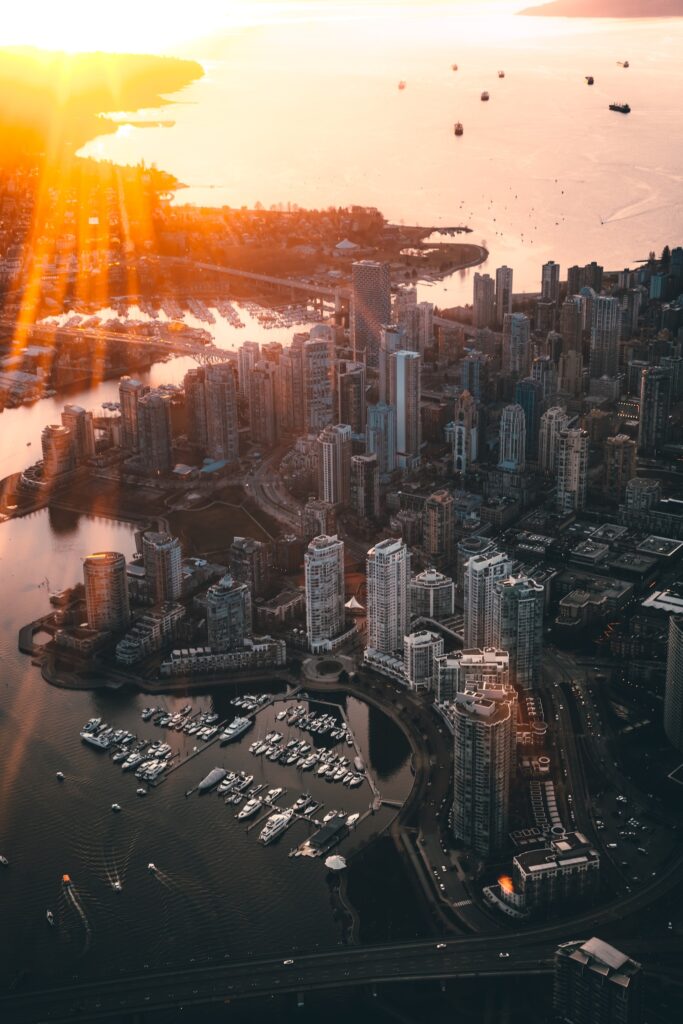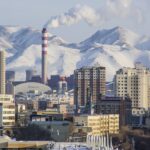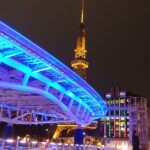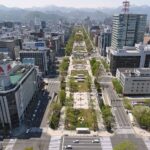In Vancouver, the public transportation system is dependable and effective. Buses, SkyTrain, SeaBus, and West Coast Express make up the transportation network. The SkyTrain is a three-line electric rail system that connects the majority of the city’s key areas. A passenger ferry called the SeaBus connects the city center with the North Shore. While the West Coast Express is a commuter train route that connects Vancouver to the cities of Port Moody, Coquitlam, Pitt Meadows, Port Coquitlam, and Mission, buses are a practical and affordable way to get around the city. The Vancouver Taxi Association additionally provides trips all throughout the city. Getting around Vancouver is simple and practical due to the abundance of options.
Basic information about the Metro system in Vancouver
The Greater Vancouver area, which includes the cities of Vancouver, Burnaby, New Westminster, and Surrey, is served by the SkyTrain, a metro system in Vancouver. This system of fast light-rail trains is made up of three lines: Expo, Millennium, and Canada. It runs every day from 5:30 a.m. until 1:30 a.m., with a frequency of every 2 to 7 minutes depending on the hour. The British Columbia Rapid Transit Company, which is owned by the provincial government, runs the system. With more than 400,000 passengers boarding each day, it is one of North America’s most effective public transportation networks.
The lines of the Vancouver subway system
The rapid transit system that serves the Canadian city of Vancouver is called the Vancouver Subway. It is run by TransLink and has three lines and 39 stops. For commuters, the system offers an easy and effective way to travel within the city and to its surroundings.
The Expo Line, the first line, stretches from King George station in Surrey to Waterfront station in Downtown Vancouver and was inaugurated in 1986. The 20.2-kilometer (12.6-mile) long line has 16 stops. It travels through the cities of Vancouver, Burnaby, and New Westminster and connects to the SkyTrain and West Coast Express, among other public transportation options.
The Millennium Line, which connects Lafarge Lake-Douglas station in Coquitlam with VCC-Clark station in Vancouver, is the second line. It debuted in 2002. There are 13 stops along the 18.2 kilometre (11.3 mi) long line. It travels through Vancouver and Burnaby and links to the West Coast Express and Canada Line, among other transit options.
The third line, the Canada Line, opened in 2009 and connects YVR-Airport station in Richmond with Waterfront station in downtown Vancouver. There are 10 stops along the 19.2 kilometer (11.9 mi) long line. It travels through Richmond, Vancouver, and the Vancouver International Airport and links to the SkyTrain and West Coast Express, among other public transportation options.
The Vancouver Subway offers a quick and practical means of getting about the city. It is a frequent, efficient, and safe public transportation system that runs day and night. Since other transit lines have been added to the subway, it is easy to get to other parts of the Greater Vancouver area.
Map of Vancouver Metro 2023 – Free Download in PDF
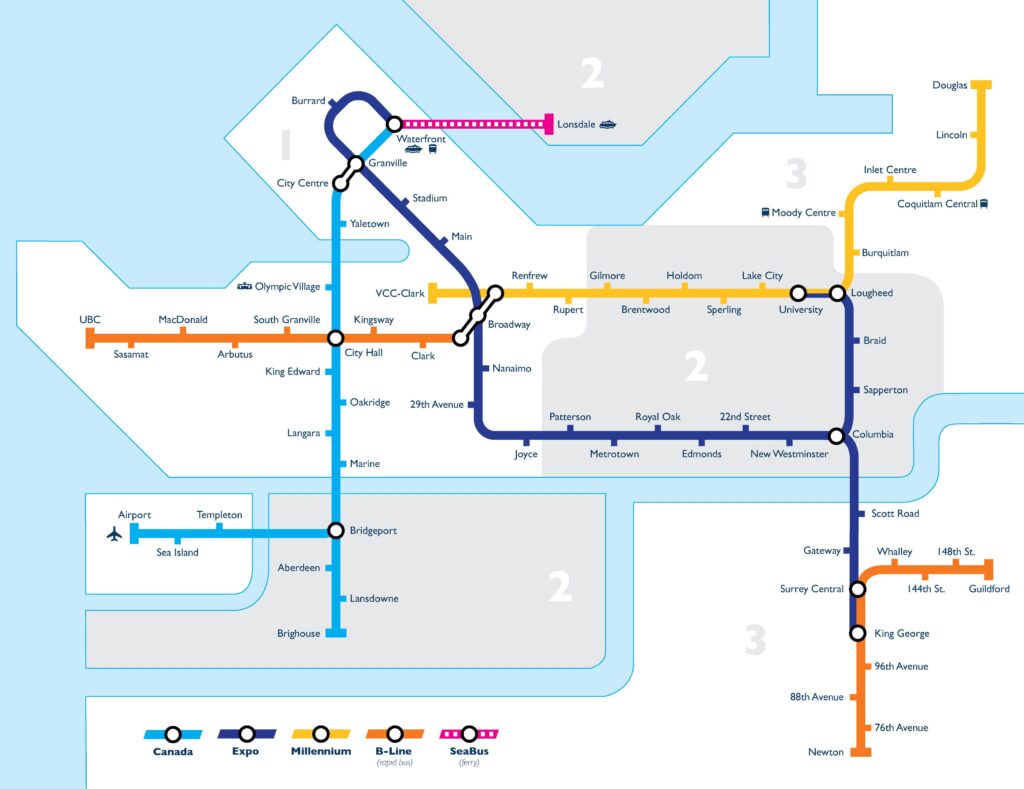
Anyone wishing to discover the city and all of its wonders should check out the Metro 2023 Map of Vancouver. People can use the map on any device, anywhere, by downloading it for free in PDF format. It gives a current picture of the city and is thorough and simple to read. It has a lot of information about each community, as well as travel options and places to visit. With this map, anyone can quickly learn about the city and make travel plans.
Public transport tickets in Vancouver – Best types for travelers & actual prices
Vancouver is a thriving, action-packed city with lots of places to explore and things to do. The public transportation system is a great way to get about. The city is simple to navigate with buses, trains, and ferries, and tickets may be bought for any of the available modes of transportation.
TransLink is responsible for running Vancouver’s public transportation system. Ticket options vary based on how frequently you intend to use the system. The most widely used tickets are single-use, daily, and monthly passes.
Single-use tickets are a practical choice for people who only infrequently plan to use the public transportation system. These tickets can be bought at any of the city’s ticket machines, and they are good for just one one-way journey. Single-use tickets cost between $2.75 and $5, but the price depends on the route you choose.
For people who intend to use the public transportation system several times in one day, day passes are an excellent choice. A day pass costs $10 and entitles the holder to unlimited rides on any public transportation system. After 3 a.m., day passes are no longer valid.
The most affordable choice for frequent travellers is monthly passes. For the duration of the month, these passes are good for an unlimited number of rides on any public transportation service. A monthly pass is $91 in price.
There are numerous other ticket choices available in addition to single-use tickets, day passes, and monthly subscriptions. Tickets for seniors, children, and people with disabilities are among them. Be sure to visit the TransLink website for more details on ticket costs and eligibility.
In general, Vancouver’s public transportation system is a great method to move around the city. Finding the right ticket choice for your needs is simple thanks to the range of available alternatives. There is bound to be a ticket option that works for you whether you travel sometimes or frequently.
Summary of fares for public transport in Vancouver
- Single-use tickets are good for one-way trips and cost between $2.75 and $5 depending on the route picked.
- Day passes are good for unlimited rides and cost $10, valid until 3 am.
- Monthly passes are good for unlimited rides and cost $91 in Vancouver.
- There are additional ticket choices available for elders, kids, and individuals with impairments.
Timetables & Schedules of the Vancouver Metro system
Monday through Sunday, the Vancouver Metro system is open from 5 a.m. to 1 a.m. The service is available on weekends and holidays from 5:30 a.m. to 12:30 a.m. During peak hours, trains operate every 3–6 minutes, and during off-peak hours, they run every 8–12 minutes. Depending on the location and time of day, the frequency of service varies. The transit system’s mainstay, the SkyTrain, runs from 5 a.m. to 1 a.m. every day, with trains departing every 5-7 minutes in rush hour and every 15 minutes in off-peak. During rush hour, trains operate every 2–3 minutes on several routes, increasing service frequency. At 12:45 AM, the final train of the evening departs from downtown Vancouver.
What Are Other Options For Public Transportation In Vancouver
In Vancouver, public transit is an essential component of daily life, and the Metro is just one of the many ways to travel around the city. Here, we’ll discuss some of the many transportation options available in Vancouver, such as buses, ferries, car sharing, and bike sharing.
One of Vancouver’s simplest and most practical public transit options is the bus. The city’s extensive TransLink bus network links the Metro with other modes of transit like ferries and SkyTrain. Bus routes go through most of the city, and they run on a regular schedule. The cost varies according to the distance and journey time.
Another practical mode of public transit in Vancouver is the ferry. There are various lines connecting the downtown area with the Metro, and the TransLink ferry system travels between the North Shore and West Vancouver. The ferries are a great way to get around the city and see the sights along the water. The route and time of day affect the cost.
In Vancouver, bike sharing is also gaining popularity. A service called Mobi Bikes allows users to rent bicycles from various locations throughout the city. Rental bicycles are available for both short outings and longer rides. Depending on how much and how far you ride, different bike rentals have different prices.
In Vancouver, car sharing is also an option. Users can rent automobiles from Car2Go on an hourly or daily basis using the app. There are Car2Go sites all across the city where users can pick up and drop off vehicles. The cost of renting a car depends on how far and how long you drive.
Overall, Vancouver offers a variety of public transit choices. There are many options to move around the city, including buses, ferries, bikes, and vehicle sharing. With a little bit of investigation, you can select the best option for your needs.
How To Get From Vancouver International Airport (YVR) To The City Center With Public Transport?
Public transit makes travelling from Vancouver International Airport (YVR) to the city centre simple and practical. From the different ways to get around, travelers can choose the best one for their needs and budget.
The most efficient and direct route from YVR to the city core is the Canada Line. The Canada Line is a fast rail line that goes from the airport to downtown in less than 30 minutes. It is also close to a lot of places that are useful. Templeton Station is the closest station to the international terminal. You can get there from either the domestic or international terminal. The cost of a single adult trip on the Canada Line starts at $4.50 when purchased from machines at the station.
You also have the choice of taking a bus from the airport if the Canada Line is not practical for your travel requirements. The N15 bus makes several stops as it travels from YVR to downtown Vancouver. Tickets can be bought at the bus stop ticket machines, and adult single-ride costs start at $2.75. The bus ride to the city center is about 40 minutes long.
There are other transportation options, such as taking a cab or using a ride-sharing service, for people who want to reach the city centre more casually. Taxi costs normally start at $35 and increase based on distance at the taxi stands outside the domestic and international terminals. Another choice is to use ride-sharing services like Uber and Lyft, which are accessible from the airport’s designated pickup areas.
Whichever route you select, using public transportation to travel from YVR to the city centre is simple and practical. Because there are so many options, travelers can quickly find the best mode of transportation for their needs and budget.
What kinds of sights should you see if you’re visiting Vancouver for the first time?
Tourists from all over the world flock to Vancouver, Canada because of its breathtaking scenery and vibrant culture. Planning a visit might be challenging because there is so much to see and see. Here is a list of the top Vancouver attractions to assist you.
The famous Stanley Park is first on the list. This 1,000-acre park, one of the largest urban parks in the world, is situated on the western edge of downtown Vancouver. There are many places to visit, like the Vancouver Seawall, the Totem Poles, and the Vancouver Aquarium. Stanley Park is the perfect place to enjoy nature in the middle of the city, whether you want to take a slow stroll or climb up a steep hill.
Then go to Granville Island with a bustling public market, galleries, and small stores, this formerly industrial district has been converted into a centre of culture and leisure. You can also go on a boat excursion to see the lovely False Creek region and admire the vistas of downtown Vancouver.
Visit the Capilano Suspension Bridge for a singular experience. This suspension bridge, which crosses the Capilano River, is 230 feet above the canyon and provides breathtaking views of the surroundings. The Treetops Adventure, Cliffwalk, and the Story Centre are just a few of the neighboring attractions.
Visit Gastown lastly. The oldest in Vancouver, this historic district is an excellent site to learn about the history of the city. The vibrant Victorian structures, the Gastown Steam Clock, and the cobblestone streets may all be seen on a self-guided walking tour.
Vancouver offers a wide variety of experiences for people of all interests. These are just a few of the best places to see in the city, but there is so much more to explore that you are sure to find something you adore.
Summary of our tour guide for Vancouver
Vancouver is a great city with beautiful mountains, stunning views of the ocean, and food that is known all over the world. There is something for everyone in this dynamic, diversified metropolis. Vancouver has a robust public transportation system that makes getting about without a car simple. The city’s bus system and SkyTrain light rail system are easy and reliable ways to get around, making it easy to see all of Vancouver’s great sights.
Top 5 FAQs and answers about Vancouver public transport?
- How many different kinds of public transit are there in Vancouver?
- SkyTrain, buses, and ferries are all part of a vast transportation system in Vancouver. Three lines of the automated rapid transit system known as the SkyTrain link suburban areas and downtown Vancouver. The city also has a comprehensive bus system that serves the entire city, including the downtown region. Additionally, the TransLink system runs a comprehensive ferry service on False Creek and Burrard Inlet.
- How much does using Vancouver’s public transit cost?
- Depending on the service you take, public transportation in Vancouver has a range of prices. Bus, SkyTrain, and ferry one-way tickets range from $2.50 to $8.50. Along with daily and monthly passes, TransLink also provides senior and kid fares that are lower.
- How frequently do ferries, SkyTrains, and buses operate?
- All day and night, buses, SkyTrains, and ferries operate frequently. Every day of the week, from 5 am to 1 am, the SkyTrain operates. Buses and ferries normally run seven days a week from 6 am to 12 am.
- How can I pay for Vancouver’s public transportation?
- Cash, debit, or credit cards are accepted in Vancouver for paying for public transportation. Compass Cards, a type of electronic payment system provided by TransLink, can be ordered online or through certain merchants.
- Do those with disabilities receive any special services?
- Yes, a variety of unique services are provided for those with impairments through TransLink. This includes specialist services like the HandyDART and Paratransit as well as accessible buses, SkyTrains, and ferries.
Useful links

